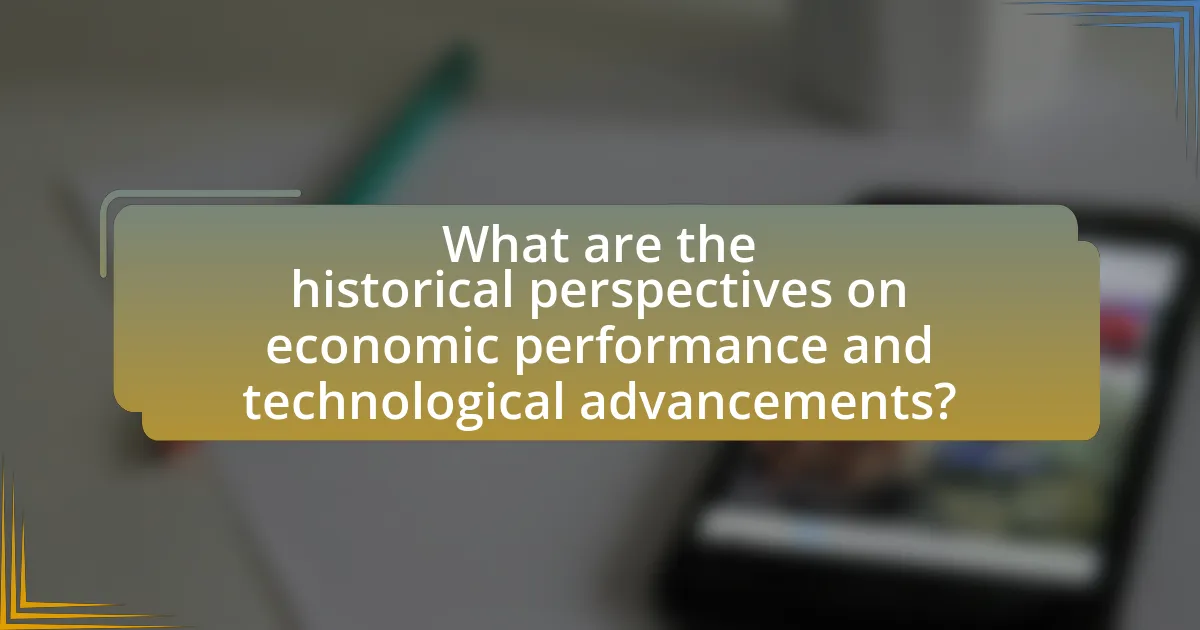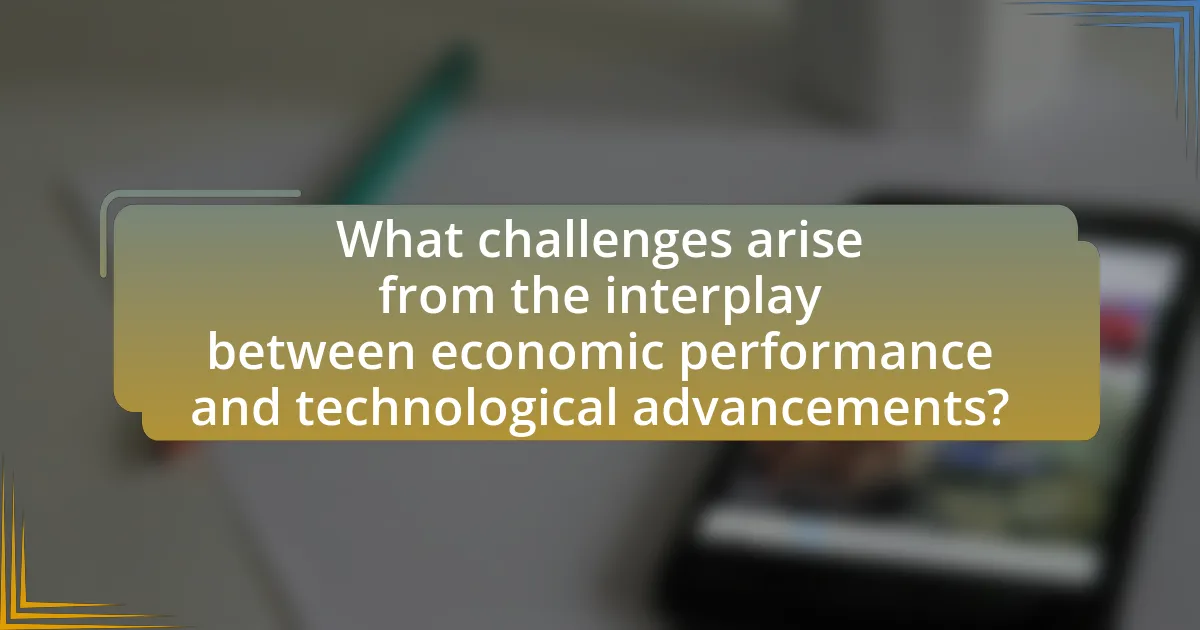The article examines the reciprocal relationship between economic performance and technological advancements, highlighting how innovations drive economic growth while economic conditions shape technological development. It discusses key indicators of economic performance, such as GDP and unemployment rates, and illustrates how technological advancements, particularly in automation and artificial intelligence, enhance productivity and efficiency. The article also addresses the role of policymakers and governments in fostering innovation, the historical context of technological revolutions, and the challenges posed by rapid technological change, including job displacement and income inequality. Finally, it outlines strategies for ensuring equitable access to technology and preparing the workforce for future demands.

What is the Interplay Between Economic Performance and Technological Advancements?
The interplay between economic performance and technological advancements is characterized by a reciprocal relationship where technological innovations drive economic growth, while economic conditions influence the pace and direction of technological development. For instance, advancements in information technology have significantly increased productivity, contributing to GDP growth; the World Bank reported that countries investing in technology saw an average GDP increase of 1.5% annually. Conversely, a robust economy provides the necessary resources for research and development, enabling further technological breakthroughs. This dynamic illustrates how technological progress can enhance economic performance, while a thriving economy fosters an environment conducive to innovation.
How do economic performance and technological advancements influence each other?
Economic performance and technological advancements mutually influence each other by driving growth and innovation. Economic performance, measured by metrics such as GDP, provides the resources and market demand necessary for investment in technology. For instance, countries with higher GDP often allocate more funds to research and development, leading to technological breakthroughs. Conversely, technological advancements enhance economic performance by increasing productivity and efficiency. For example, the introduction of automation in manufacturing has significantly boosted output and reduced costs, contributing to economic growth. This reciprocal relationship is evident in historical data, such as the post-World War II economic boom, which was fueled by technological innovations like computers and telecommunications, resulting in sustained economic expansion.
What are the key indicators of economic performance?
Key indicators of economic performance include Gross Domestic Product (GDP), unemployment rate, inflation rate, and trade balance. GDP measures the total value of goods and services produced in a country, reflecting overall economic activity. The unemployment rate indicates the percentage of the labor force that is jobless and actively seeking employment, serving as a gauge of economic health. The inflation rate measures the rate at which the general level of prices for goods and services rises, eroding purchasing power. Lastly, the trade balance, which is the difference between a country’s exports and imports, provides insight into its economic strength in the global market. These indicators are widely used by economists and policymakers to assess and compare economic performance across different countries and time periods.
How do technological advancements drive economic growth?
Technological advancements drive economic growth by increasing productivity and efficiency across various sectors. For instance, the introduction of automation and artificial intelligence in manufacturing has led to significant reductions in production costs and time, enabling companies to produce more goods at a lower price. According to a report by McKinsey Global Institute, automation could increase global productivity by up to 1.4% annually. Additionally, advancements in information technology have facilitated better communication and data management, allowing businesses to make informed decisions that enhance operational efficiency. This correlation between technology and economic growth is further supported by historical data, which shows that countries investing in technology tend to experience higher GDP growth rates.
Why is understanding this interplay important for policymakers?
Understanding the interplay between economic performance and technological advancements is crucial for policymakers because it directly influences their ability to foster sustainable growth and innovation. Policymakers must recognize that technological advancements can drive economic performance by increasing productivity and creating new markets, as evidenced by the rise of the digital economy, which contributed approximately $2 trillion to the U.S. GDP in 2020. Additionally, understanding this relationship allows policymakers to implement targeted strategies that support research and development, ensuring that technological progress aligns with economic goals, ultimately leading to improved living standards and job creation.
What role do governments play in fostering technological innovation?
Governments play a crucial role in fostering technological innovation by providing funding, creating favorable policies, and facilitating collaboration between public and private sectors. For instance, government investments in research and development (R&D) can significantly enhance innovation; the National Science Foundation reported that federal R&D funding in the United States reached approximately $150 billion in 2020, supporting advancements in various fields. Additionally, governments implement regulations and incentives that encourage private sector investment in technology, such as tax credits for R&D activities. Furthermore, public-private partnerships, exemplified by initiatives like the Small Business Innovation Research program, enable startups to access resources and expertise, driving innovation. These actions collectively create an environment conducive to technological advancements, demonstrating the essential role of governments in this process.
How can economic policies support technological development?
Economic policies can support technological development by providing funding, tax incentives, and regulatory frameworks that encourage innovation. For instance, government investments in research and development (R&D) can lead to advancements in technology, as seen in the United States where federal funding for R&D has historically spurred significant technological breakthroughs, such as the internet and biotechnology. Additionally, tax incentives for companies investing in new technologies can stimulate private sector innovation, as evidenced by the UK’s Patent Box regime, which offers reduced tax rates on profits from patented inventions, thereby promoting technological advancements. Furthermore, effective regulatory frameworks can create a conducive environment for startups and tech firms to thrive, as demonstrated by Singapore’s pro-business policies that have positioned it as a global tech hub.

What are the historical perspectives on economic performance and technological advancements?
Historical perspectives on economic performance and technological advancements indicate a strong correlation between the two, where technological innovations often drive economic growth. For instance, during the Industrial Revolution in the 18th and 19th centuries, advancements in machinery and manufacturing processes significantly increased productivity, leading to substantial economic expansion in Europe and North America. Additionally, the introduction of the internet in the late 20th century transformed global economies by enabling new business models and enhancing efficiency, contributing to the rise of the digital economy. Studies, such as those by the National Bureau of Economic Research, highlight that countries investing in technology tend to experience higher GDP growth rates, reinforcing the idea that technological progress is a key driver of economic performance.
How have past technological revolutions impacted economic performance?
Past technological revolutions have significantly enhanced economic performance by increasing productivity and creating new markets. For instance, the Industrial Revolution, which began in the late 18th century, led to the mechanization of production processes, resulting in a dramatic rise in output and efficiency. This period saw the introduction of steam power and machinery, which transformed industries such as textiles and manufacturing, contributing to GDP growth in countries like Britain and the United States.
Similarly, the Information Technology Revolution, starting in the late 20th century, revolutionized communication and data processing. The widespread adoption of computers and the internet facilitated global trade, reduced transaction costs, and enabled the emergence of new business models, such as e-commerce. According to a report by the McKinsey Global Institute, digital technologies have the potential to add $13 trillion to global GDP by 2030, underscoring the profound impact of technological advancements on economic performance.
Overall, historical evidence demonstrates that technological revolutions have consistently driven economic growth by fostering innovation, improving efficiency, and expanding market opportunities.
What lessons can be learned from the Industrial Revolution?
The Industrial Revolution teaches that technological advancements can significantly enhance economic performance. For instance, the introduction of steam power and mechanized manufacturing led to increased productivity and the growth of industries, which transformed economies from agrarian to industrial. Historical data shows that between 1760 and 1840, Britain’s GDP per capita grew substantially, reflecting the economic impact of these innovations. Additionally, the Industrial Revolution highlights the importance of adapting to change; societies that embraced new technologies experienced economic growth, while those that resisted faced stagnation. This period also underscores the need for regulatory frameworks to address the social consequences of rapid industrialization, such as labor exploitation and environmental degradation.
How did the Digital Revolution change economic landscapes?
The Digital Revolution transformed economic landscapes by enabling unprecedented levels of connectivity, efficiency, and innovation. This shift allowed businesses to leverage digital technologies, resulting in the emergence of new markets and the disruption of traditional industries. For instance, the rise of e-commerce platforms like Amazon has fundamentally altered retail, leading to a significant decline in brick-and-mortar stores. Additionally, the automation of processes through technologies such as artificial intelligence and machine learning has increased productivity across various sectors, contributing to economic growth. According to a McKinsey report, digital technologies could add $13 trillion to global GDP by 2030, illustrating the profound impact of the Digital Revolution on economic structures and performance.
What are the current trends in the interplay between these two entities?
Current trends in the interplay between economic performance and technological advancements indicate a strong correlation where technological innovation drives economic growth. For instance, advancements in artificial intelligence and automation have significantly increased productivity across various sectors, leading to higher GDP growth rates in countries that adopt these technologies. According to a report by McKinsey Global Institute, AI could contribute an additional $13 trillion to global economic output by 2030, highlighting the substantial impact of technology on economic performance. Furthermore, the integration of digital technologies in traditional industries has resulted in enhanced efficiency and cost reduction, further reinforcing the link between technological progress and economic prosperity.
How is artificial intelligence affecting economic productivity?
Artificial intelligence is significantly enhancing economic productivity by automating tasks, optimizing processes, and enabling data-driven decision-making. For instance, McKinsey Global Institute reported that AI could potentially add $13 trillion to global economic output by 2030, primarily through increased efficiency and innovation across various sectors. This automation reduces labor costs and increases output, allowing businesses to scale operations more effectively. Additionally, AI-driven analytics provide insights that lead to better resource allocation and improved customer experiences, further driving productivity gains.
What is the impact of automation on employment and economic growth?
Automation generally leads to job displacement in certain sectors while simultaneously creating new opportunities in others, resulting in a net effect that can vary across different industries. For instance, a report by the McKinsey Global Institute indicates that by 2030, up to 375 million workers globally may need to switch occupational categories due to automation. This shift can enhance economic growth by increasing productivity; the World Economic Forum estimates that automation could contribute an additional $14 trillion to the global economy by 2030. Thus, while automation poses challenges for employment in specific roles, it also drives economic growth through efficiency gains and the creation of new job categories.

What challenges arise from the interplay between economic performance and technological advancements?
The interplay between economic performance and technological advancements presents several challenges, including job displacement, income inequality, and the need for continuous skill development. Job displacement occurs as automation and advanced technologies replace traditional roles, leading to unemployment in certain sectors. For instance, a report by the McKinsey Global Institute estimates that up to 800 million jobs could be lost globally by 2030 due to automation. Income inequality is exacerbated as high-skilled workers benefit disproportionately from technological advancements, while low-skilled workers face stagnating wages. Additionally, the rapid pace of technological change necessitates ongoing education and training, creating a skills gap that can hinder economic growth. According to the World Economic Forum, 54% of all employees will require significant reskilling by 2022 to keep pace with technological changes.
What are the potential negative effects of rapid technological change?
Rapid technological change can lead to job displacement, increased inequality, and social disruption. As automation and artificial intelligence advance, many traditional jobs become obsolete, resulting in significant unemployment in certain sectors. For instance, a report by the McKinsey Global Institute estimates that up to 800 million jobs could be displaced globally by 2030 due to automation. Additionally, rapid technological advancements often benefit those with access to education and resources, exacerbating income inequality. A study by the Pew Research Center found that lower-income individuals are less likely to have the skills needed for new technology-driven jobs, widening the economic gap. Furthermore, the swift pace of change can lead to social unrest, as communities struggle to adapt to new technologies and the accompanying shifts in labor markets and social structures.
How can technological advancements lead to economic inequality?
Technological advancements can lead to economic inequality by disproportionately benefiting those with access to education, skills, and resources necessary to leverage new technologies. For instance, the rise of automation and artificial intelligence has created a demand for high-skilled workers while displacing low-skilled jobs, resulting in wage polarization. According to a report by the McKinsey Global Institute, up to 375 million workers globally may need to change occupations due to automation by 2030, highlighting the risk of increased unemployment and income disparity among those unable to adapt. Additionally, companies that invest in advanced technologies often see significant productivity gains, which can lead to higher profits concentrated among a small number of stakeholders, further exacerbating wealth inequality.
What risks do businesses face in adapting to new technologies?
Businesses face several risks when adapting to new technologies, including financial investment risks, operational disruptions, and cybersecurity threats. Financial investment risks arise from the significant costs associated with implementing new technologies, which may not yield immediate returns, leading to potential cash flow issues. Operational disruptions can occur during the transition period, affecting productivity and employee morale as staff adapt to new systems. Cybersecurity threats increase as businesses integrate new technologies, making them more vulnerable to data breaches and cyberattacks. According to a report by McKinsey, 70% of digital transformation initiatives fail, often due to inadequate change management and resistance from employees, highlighting the importance of addressing these risks effectively.
How can these challenges be addressed effectively?
To address the challenges between economic performance and technological advancements effectively, policymakers must implement targeted strategies that foster innovation while ensuring economic stability. For instance, investing in education and workforce training equips individuals with the necessary skills to adapt to technological changes, thereby enhancing productivity. According to a report by the World Economic Forum, countries that prioritize education and skills development see a 20% increase in economic growth over a decade. Additionally, creating a regulatory environment that encourages research and development can stimulate technological innovation, as evidenced by the increase in patent filings in regions with supportive policies. These approaches collectively mitigate the risks associated with rapid technological change while promoting sustainable economic growth.
What strategies can be implemented to ensure equitable technological access?
To ensure equitable technological access, strategies such as expanding broadband infrastructure, providing subsidies for low-income households, and implementing digital literacy programs can be effectively utilized. Expanding broadband infrastructure addresses the digital divide by ensuring that underserved areas have reliable internet access, which is essential for participation in the digital economy. According to the Federal Communications Commission, as of 2021, approximately 14 million Americans still lack access to high-speed internet, highlighting the need for infrastructure investment. Providing subsidies for low-income households can alleviate financial barriers, enabling more individuals to afford necessary devices and services. Programs like the Affordable Connectivity Program have shown success in increasing access among low-income families. Lastly, implementing digital literacy programs equips individuals with the skills needed to navigate technology effectively, fostering greater inclusion in the digital landscape. Research from the Pew Research Center indicates that digital skills are crucial for economic mobility, reinforcing the importance of these educational initiatives.
How can education systems adapt to prepare the workforce for technological changes?
Education systems can adapt to prepare the workforce for technological changes by integrating technology-focused curricula and fostering critical thinking and problem-solving skills. This adaptation involves updating educational content to include emerging technologies such as artificial intelligence, data analytics, and coding, which are increasingly relevant in the job market. For instance, a report by the World Economic Forum indicates that by 2025, 85 million jobs may be displaced by a shift in labor between humans and machines, while 97 million new roles could emerge that are more adapted to the new division of labor. Therefore, education systems must also emphasize lifelong learning and reskilling programs to ensure that the workforce remains competitive and capable of adapting to rapid technological advancements.
What best practices can organizations adopt to leverage this interplay?
Organizations can adopt several best practices to leverage the interplay between economic performance and technological advancements. Firstly, they should invest in continuous training and development programs to enhance employee skills in emerging technologies, which can lead to improved productivity and innovation. For instance, a study by McKinsey found that companies that prioritize employee training in technology see a 20% increase in productivity.
Secondly, organizations should foster a culture of innovation by encouraging collaboration across departments, which can lead to the development of new products and services that enhance economic performance. Research from Harvard Business Review indicates that companies with collaborative cultures are 5 times more likely to be high-performing.
Additionally, organizations should implement data-driven decision-making processes to optimize resource allocation and identify growth opportunities. According to a report by Deloitte, data-driven organizations are 23 times more likely to acquire customers and 6 times more likely to retain them.
Lastly, organizations should establish strategic partnerships with technology firms to access cutting-edge innovations and integrate them into their operations, thereby enhancing their competitive edge. A study by PwC highlights that 72% of executives believe that partnerships are crucial for driving innovation.
How can businesses integrate technology to enhance economic performance?
Businesses can integrate technology to enhance economic performance by adopting automation, data analytics, and digital platforms. Automation streamlines operations, reducing labor costs and increasing efficiency; for instance, companies that implement robotic process automation can see productivity gains of up to 30%. Data analytics enables businesses to make informed decisions by analyzing market trends and consumer behavior, which can lead to targeted marketing strategies and improved customer satisfaction. Additionally, utilizing digital platforms for e-commerce expands market reach, with global e-commerce sales projected to surpass $6 trillion by 2024, demonstrating the significant economic impact of technology integration.
What role does innovation play in sustaining economic growth?
Innovation is crucial for sustaining economic growth as it drives productivity improvements and creates new markets. By introducing new technologies and processes, businesses can enhance efficiency, reduce costs, and increase output. For instance, the introduction of automation and artificial intelligence has significantly boosted productivity in various sectors, contributing to GDP growth. According to a report by the McKinsey Global Institute, advancements in technology could add $13 trillion to global GDP by 2030, highlighting the substantial impact of innovation on economic performance.


